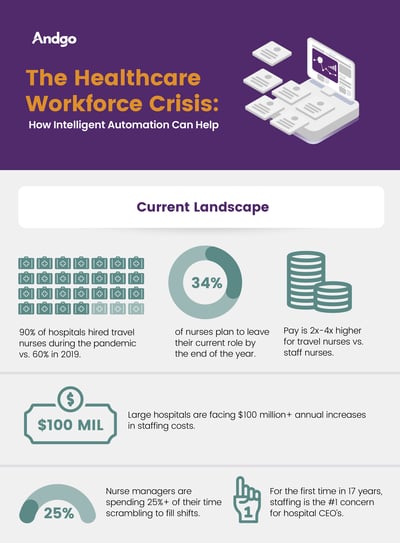Share this
Healthcare Staff Shortages: How Intelligent Automation Can Help Maximize Your Internal Resources
by Andgo Systems on Aug 17, 2022
Background
With the lasting effects of the COVID-19 pandemic raging on across the globe, it’s no surprise hospitals are continuing to feel immense staffing pressures. For the first time in nearly two decades, hospital CEOs ranked staffing challenges as their top concern in 2021. Furthermore, it’s estimated that 34% of all nurses plan to leave their job by the end of 2022 and 18% of healthcare workers already have. As a result, many healthcare organizations are left relying on external travel nurse agencies to help them fill gaps in care; but these travel nurse contracts are not without their own challenges.
On average, travel nurses are paid 2x-4x times more than their staff nurse counterparts, with some contracts earning over $10,000 per week. In fact, US travel nursing revenue tripled to $12 billion in the past six years, and some hospitals report a roughly 100% increase in staffing budgets year-over-year.
So what drives these increases? Well, it’s largely due to supply and demand – the same driving force behind rising grocery prices, housing shortages, and toilet paper catastrophes. As nurses leave their fields in favor of calmer, more sustainable work environments, understaffing gaps begin to form in patient care. To fill those voids, healthcare organizations turn to short-term, contract travel nurses. In 2020, 90% of U.S. hospital executives brought in travel nurses to boost their departments, compared to less than 60% the year prior.
But not all healthcare workers are leaving the industry as a whole; many are voluntarily leaving their staff positions in favor of those high-paying, high-demand travel nurse contracts. This creates a dangerous feedback loop: hospital administrators have their hands tied and pour money into bringing on numerous contract nurses to fill gaps in care, thus leaving them financially unable to increase existing staff nurse salaries. And so the cycle repeats itself, with staff nurses quitting for higher paying roles – driving even more demand for their services – and leaving their former staff coworkers behind with no pay increases in sight.
Impactful Outcomes - How Andgo Can Help
By intelligently automating your absence and shift filling workflows, Andgo empowers you to optimize the usage of your internal workforce first before hiring externally. As a result, Andgo increases your organization’s efficiency and supports improved employee satisfaction and retention rates.
Actionable Insights
Intelligently automating the absence workflow process provides transparency into the real-time movement of staff across the organization. This empowers teams to quickly identify the most critical shifts to fill.
Fill More Shifts Faster
Responsive shift-filling is 9x faster while reducing the sheer volume of unfilled shifts. Andgo customers have filled 7x more shifts, compared to previous manual processes.
Leverage Internal Resources First
Intelligent automation provides a holistic, streamlined approach to strategically fill shifts with internal staff first before having to bring in external travel nurses. By filling just 20% more vacant shifts with staff nurses instead of using agencies, a 20,000-employee hospital system could save $10 million+ annually.
Click on this infographic👇 to learn more:
References
Share this
- November 2025 (1)
- October 2025 (3)
- August 2025 (4)
- June 2025 (2)
- May 2025 (1)
- April 2025 (1)
- March 2025 (2)
- February 2025 (4)
- January 2025 (1)
- December 2024 (2)
- November 2024 (1)
- October 2024 (2)
- June 2024 (1)
- October 2023 (1)
- September 2023 (1)
- August 2023 (1)
- July 2023 (4)
- May 2023 (2)
- April 2023 (2)
- March 2023 (2)
- February 2023 (1)
- December 2022 (1)
- November 2022 (3)
- October 2022 (1)
- September 2022 (3)
- August 2022 (1)
- July 2022 (1)
- June 2022 (1)
- May 2022 (1)
- February 2022 (1)
- January 2022 (3)
- December 2021 (1)
- September 2021 (1)
- June 2021 (1)
- January 2021 (1)
- November 2020 (2)
- October 2020 (1)
- September 2020 (5)
- August 2020 (2)
- July 2020 (3)
- June 2020 (2)
- May 2020 (1)
- April 2020 (3)
- March 2020 (1)
- February 2020 (2)
- January 2020 (1)
- November 2019 (2)
- October 2019 (1)
- September 2019 (1)

